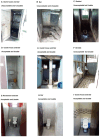Water, sanitation and hygiene at sex work venues to support menstrual needs
- PMID: 38481834
- PMCID: PMC10936742
- DOI: 10.3389/fpubh.2024.1305601
Water, sanitation and hygiene at sex work venues to support menstrual needs
Abstract
Introduction: Adequate menstrual health and hygiene (MHH) is necessary for women's health and equity of all menstruators. Female sex workers (FSW) require good MHH to prevent discomfort and exposure to pathogens. No studies have evaluated water, sanitation, and hygiene (WASH) conditions of FSW. We report on a cross-sectional WASH assessment at FSW venues in Kisumu, western Kenya.
Methods: Stakeholders identified 77 FSW venues in Kisumu, of which 47 were randomly sampled and visited between April-May 2023. A standardized structured survey of WASH conditions was deployed by trained research staff using Android tablets after proprietor's consent. WASH scores ranging 0-3 were computed based on point each for direct observation of water available, soap available, and acceptable latrine. MHH scores ranging between 0-4 were computed (one point each) for direct observation of: currently available soap and water, locking door on a usable latrine, functional lighting, and a private area for changing clothes or menstrual materials, separate from the latrine(s). WASH and MHH scores were compared by venue type using non-parametric Kruskal-Wallis tests, and non-parametric Spearman rank tests.
Results: Full WASH criteria was met by 29.8% of venues; 34.0% had no adequate WASH facilities; 46.8% had no female latrine; and 25.5% provided soap and water in private spaces for women. While 76.6% had menstrual waste disposal only 14 (29.8%) had covered bins. One in 10 venues provided adequate MHM facilities. Poorest WASH facilities were in brothels and in bars, and three-quarters of bars with accommodation had no MHH facilities.
Discussion: WASH and MHH services were sub-optimal in the majority of FSW venues, preventing menstrual management safely, effectively, with dignity and privacy. This study highlights the unmet need for MHH support for this population. Poor MHH can deleteriously impact FSW health and wellbeing and compound the stigma and shame associated with their work and ability to stay clean. Acceptable and cost-effective solutions to sustainably improve WASH facilities for these populations are needed.
Trial registration: Clinicaltrial.gov NCT0566678.
Keywords: female sex workers; menstrual health and hygiene (MHH); reproductive tract infections; sanitation and hygiene (WASH); sexual and reproductive health; waste disposal; water.
Copyright © 2024 Phillips-Howard, Osire, Akinyi, Zulaika, Otieno and Mehta.
Conflict of interest statement
The authors declare that the research was conducted in the absence of any commercial or financial relationships that could be construed as a potential conflict of interest. The author(s) declared that they were an editorial board member of Frontiers, at the time of submission. This had no impact on the peer review process and the final decision.
Figures




References
-
- WHO . Hidden Cities: Unmasking and Overcoming Health Inequities in Urban Settings. Geneva: WHO Geneva and UN Habitat; (2010).
-
- WHO . Our lifetime opportunity to enable water, sanitation and hygiene for all (2023). Available online at: https://www.who.int/news/item/22-03-2023-our-lifetime-opportunity-to-ena... (accessed May 25, 2023).
-
- WHO . Progress on Household Drinking Water, Sanitation, and Hygiene 2000-2020: Five Years into the SDGs. Geneva: WHO, UNICEF; (2021).
Publication types
MeSH terms
Substances
Grants and funding
LinkOut - more resources
Full Text Sources
Miscellaneous

